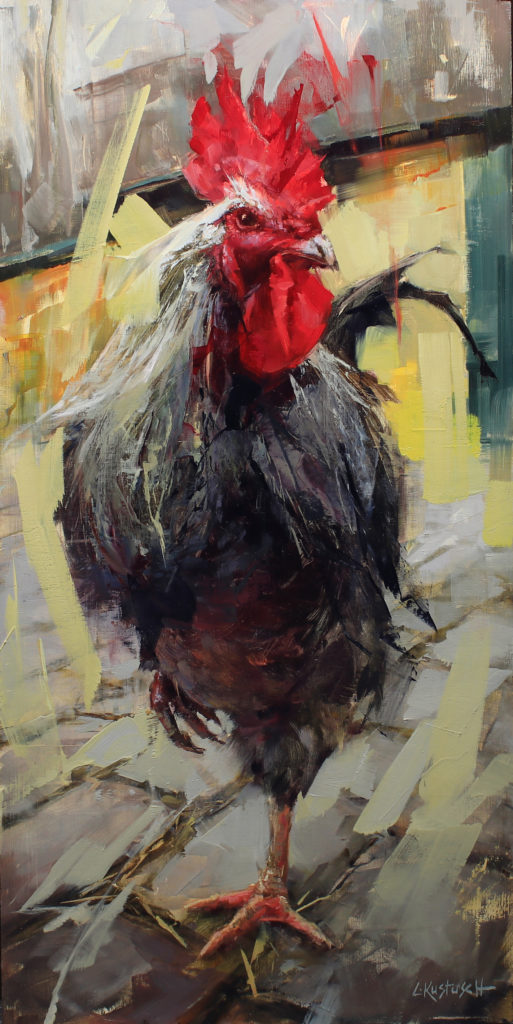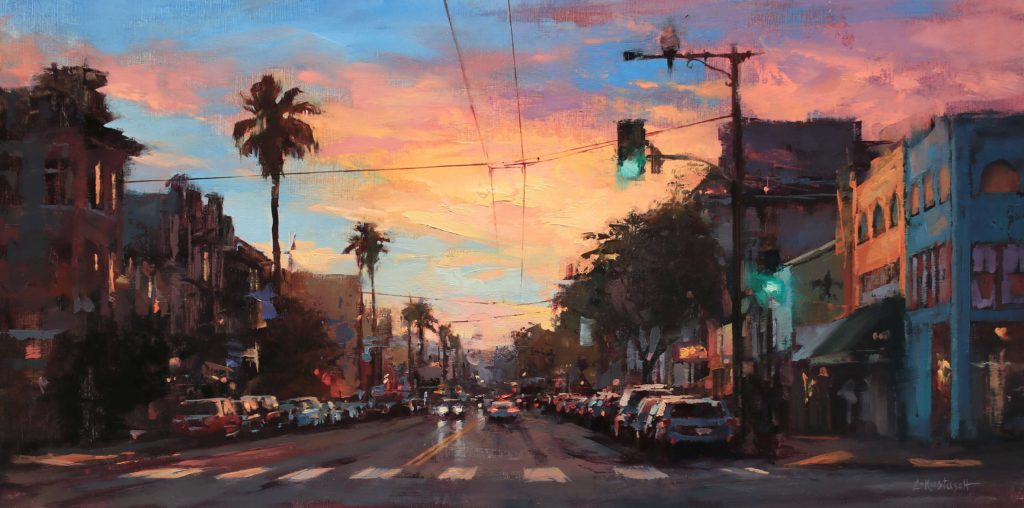Influenced by the bustle of city life, Lindsey Kustusch paints “the abstraction of how we remember our days.” Go behind the scenes of her contemporary oil paintings here.

Painting the Spaces in Between
BY LINDSEY KUSTUSCH
www.lindseykustusch.com
I am fascinated by the power of art and its ability to alter the way we see our surroundings…how everyday things can gain exquisite beauty simply because we’ve experienced it through someone else’s eyes.
That is the magic behind the paint brush. It grants us freedom to change how we see the world. It challenges the significant versus the insignificant and all of the shadowy spaces in between. It’s a memory exposed, and a loss for words defined. As the artist and the onlooker, art offers us a chance to see the things we miss.

Since I was a child, my love for art has always held equal importance to my deep connection with animals. I spent several years at art school before leaving to work for rescue organizations, edging towards a career in animal science. As rewarding as this truly was, there was something always holding me back from taking it further: the joy and wonder that comes from creating something from nothing. It was years before I picked up the paint brush again and saw oil painting for the limitless instrument that it truly is. It took following my heart and abandoning the path I was on, only to follow my heart right back to where it all began, but this time with focus and intent.
This led to hours upon hours of experimentation and “trial and error” in the studio that eventually led to a layered approach to building a painting. Making heavy use of palette knives, battered brushes, and hardware store finds, I began painting my everyday experiences in my new home in San Francisco: the impeccable beauty and the unkempt grit, the quiet and the chaotic, the nooks and crannies of my everyday commute, and the people and animals that interlaced the domestic city streets with the wild and untamed landscape of the country.
Having lived most of my life in a bustling, urban environment, my work has always been heavily influenced by city life as a whole. Every day I bring something unexpected back to the studio, fueling the exploration of new ideas, tools, and techniques, one being the abstraction of how we remember our days. Maybe it’s just the lights of the storefront at night that stand out, or the fog wrapping itself around the skyscrapers at dusk, or the sunset illuminating the hillside dappled with houses on the walk home.
We have an emotional filter on all of our memories, so by tapping into how that could be illustrated in a two-dimensional sense is the closest I can come to painting something that “feels” real. Leaving the peripheral details ambiguous forces our imagination to fill in the rest, which for me creates a deeper connection and emotional core to a work of art.

I also love the mystery of painting in layers and not knowing how each mark was made. It’s a puzzle within the riddle of the painting itself, the bits and pieces where the paint looks like it weathered the same storm as the subject. Most of all, I love the challenge of it. How do I recreate these moments in a truly “realistic” sense? What will make this real to me? That’s when the fun begins.

I typically start each studio painting the same way. I take a photo of the scene or subject and attempt to recreate the memory by adjusting my photo, giving it a clearer direction on where the painting can go. It’s a quick and easy way not to waste paint but still find the voice and “focal point” of the piece. For me this step has become the most critical. It’s when I decide what should be described with accurate detail or determine if it’s the lack of detail that will highlight its significance.

After I’ve successfully picked apart the reference I game-plan my layering strategy . . . Typically each piece starts with an underpainting followed by several back and forth sessions of detail and semi-transparent washes. I have a growing collection of tools I’ve found throughout the years that have become staple mark-makers in my process:
- I use soft rubber printmaking blocks I’ve pre-cut into various shapes and sizes to scrape washes over detailed areas to help create atmosphere and richness.
- Old brushes, destroyed from improper cleaning work as wonderful foliage makers.
- An assortment of knives is useful for detail and controlled chaos, and rubber gloves work well for finger painting.
- I use various surfaces, including wood panel and canvas either gessoed and sanded flat or left with texture.
The possibilities with oil paint are endless, which has been my favorite discovery of all.

Just as my subjects and use of pigment will be ever-evolving, so is the reason to create something in the first place. The further I explore, the clearer my intention has become: to remain aware, to see the things I might have missed, to immortalize the beauty of life on this planet, and to encourage others to do the same. It’s the little things that are the most important, and it’s the little things that make up our lives.






Connect with the artist at www.lindseykustusch.com.
> Visit EricRhoads.com to learn about more opportunities for artists and art collectors, including retreats, international art trips, art conventions, and more.
> Sign up to receive Fine Art Today, our free weekly e-newsletter
> Subscribe to Fine Art Connoisseur magazine, so you never miss an issue








